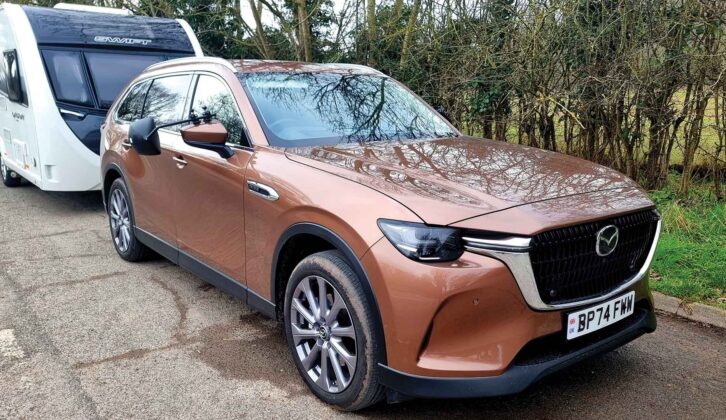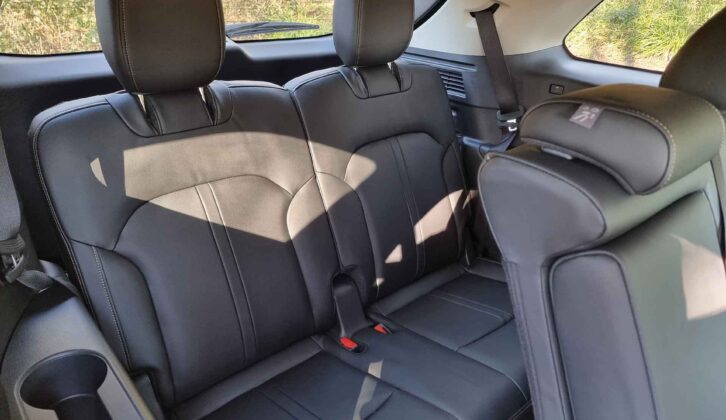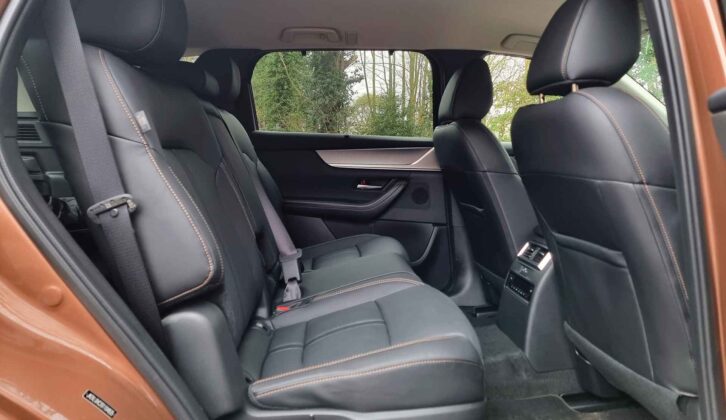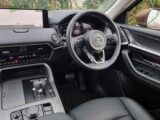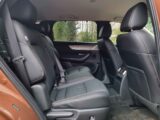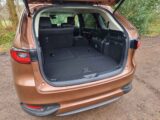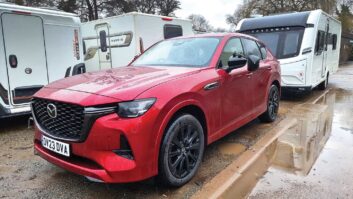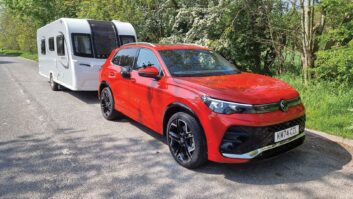Verdict
Its price pegs the Mazda between mainstream rivals and cars with premium badges. Is it worth it? That depends on how much you value the extra performance and driver-focused handling. It does make a very stable tow car.
Pros
- Stable towing
- Long list of standard kit
- Driver-focused handling
Cons
- More expensive than mainstream rivals
The CX-80 is Mazda’s latest flagship. Larger than the closely related CX-60, the new model has seven seats and offers a choice of plug-in hybrid (PHEV) and diesel power. I’ve been towing with the 3.3-litre diesel, the Mazda CX-80 3.3D AWD Exclusive Line.
What am I looking for?
Is the CX-80 better, as well as bigger, than Mazda’s other SUVs? Does the car justify a price of over £50,000 and how well does it tow a caravan?
Towing ability
As Mazda’s largest SUV, it’s no surprise that the CX-80 is a very heavy car. With a kerbweight of over two tonnes and a towing capacity of 2500kg, it will make a safe and sensible match for a wide choice of caravans (take a look at our guide to matching a car to a caravan for more advice on this).
I matched the Mazda CX-80 3.3D AWD Exclusive Line to a Swift Fairway Platinum 560 with a MiRO of 1464kg, loaned to us by Raymond James Caravans in Atherstone, Warwickshire.
The Mazda confidently towed the Swift Fairway up to speed. The 3.3-litre diesel is well suited to towing, providing 406lb ft of torque from as little as 1500rpm. That compares with 325lb ft for the Kia Sorento diesel.
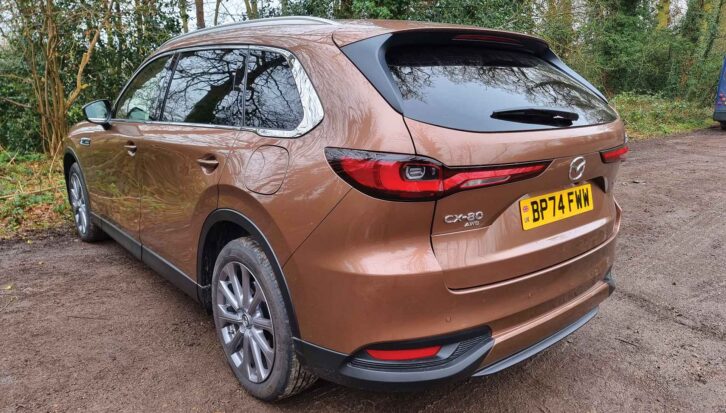
With eight-speed automatic transmission and that pulling power, the CX-80 performs very impressively, even with the weight of a sizeable tourer behind it. The Mazda holds speed well on hilly roads and has enough muscle for confident overtaking. At a steady 60mph on the motorway, the speed limit for towing a caravan, the engine has plenty in reserve.
The drive modes include a towing setting, which according to Mazda, “optimises the AWD powertrain output characteristics for the altered vehicle balance and increased weight when a towing hitch is mounted to pull a trailer.” Whether in the towing setting or not, I found the CX-80 makes a stable tow car, always a trait we look for in the best caravan tow cars.
As well as being heavier than the CX-60, the CX-80 also has a longer wheelbase (the distance between the front and the rear axles) which contributes to the Mazda’s secure towing manners, which could be something you’re looking for in a good SUV for towing a caravan.
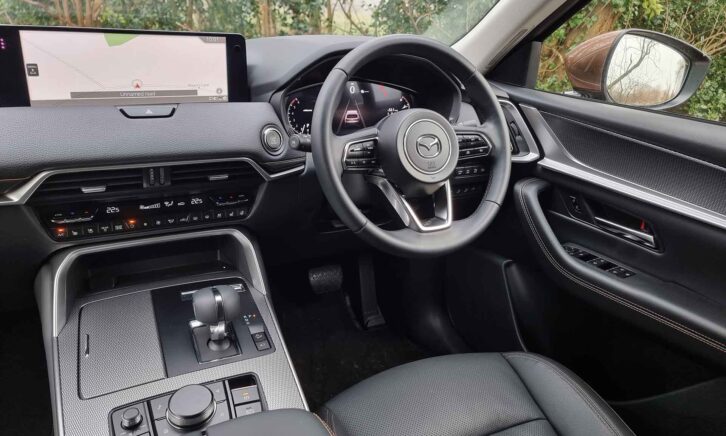
Every CX-80 is four-wheel drive. Hill starts are easy in the dry, and you’d expect them to be straightforward in wet weather, too. The electronic parking brake holds car and caravan still and releases smoothly when the driver applies the throttle. The 1-in-10 slope on my test route was no trouble at all.
If you’re thinking about having a hybrid tow car rather than a diesel as your next vehicle, the plug-in hybrid CX-80 provides the same towing capacity as the diesel and weighs around 100kg more, making for more favourable matching ratios. However, I would prefer the diesel for its more consistent fuel economy and better refinement.
Solo driving
Under the skin, the CX-80 is closely related to the CX-60, a car that is sporty to drive at the expense of ride comfort.
With the new model, Mazda has tuned the suspension for a more forgiving feel (the revised suspension is also fitted to the 2025 CX-60). The changes are partially successful. In town, the ride is still quite lumpy, but it’s smoother at speed.
On a twisting road, the CX-80 handles well for such a heavy car. It’s certainly sportier than a Kia Sorento or Škoda Kodiaq.
The engine is the same diesel used in the smaller CX-60, but it is less noisy in the CX-80.
There’s a pleasant, throaty grumble under acceleration, settling into the background once cruising. Road noise is more noticeable than the engine at the motorway limit.
Against a stopwatch, the plug-in hybrid model is quicker than the diesel. On the road, the two engines feel evenly matched for pace. Put your foot down in the PHEV while running on electricity and there’s a pause while the petrol engine wakes up. The diesel responds more quickly when the driver first presses on the throttle.
Space and practicality
Measuring just half a centimetre shy of five metres, the CX-80 is a very large car. Mazda has put that space to very good use, especially in the first two rows.
The front of the car has the usual sporty Mazda look, with the chunky three-spoke steering wheel setting the tone. There’s enough adjustment to both seat and wheel to please drivers of most shapes and sizes, and I found the seats supportive on longer journeys, which could come in handy if you’re towing long distances.
For better or worse, Mazda has a habit of doing some things differently. That’s a plus when it comes to the infotainment. The screen isn’t touch-sensitive – instead, there’s a rotary controller with shortcut buttons to navigate around the menus. This makes it easier to keep your eyes on the road.

There’s lots of space in the middle of the car, with ample legroom for tall adults. Air vents between the front seats supply chilled air and USB-C ports keep devices charged.
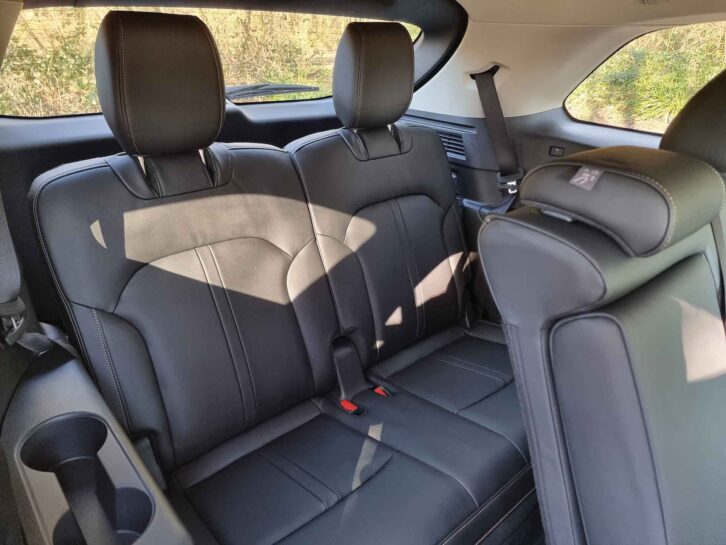
As you’d expect, the third row is less accommodating, but fine for children or adults who don’t mind being a bit cooped up for a short trip. The middle row moves on runners, giving those in seats six and seven a bit more space.
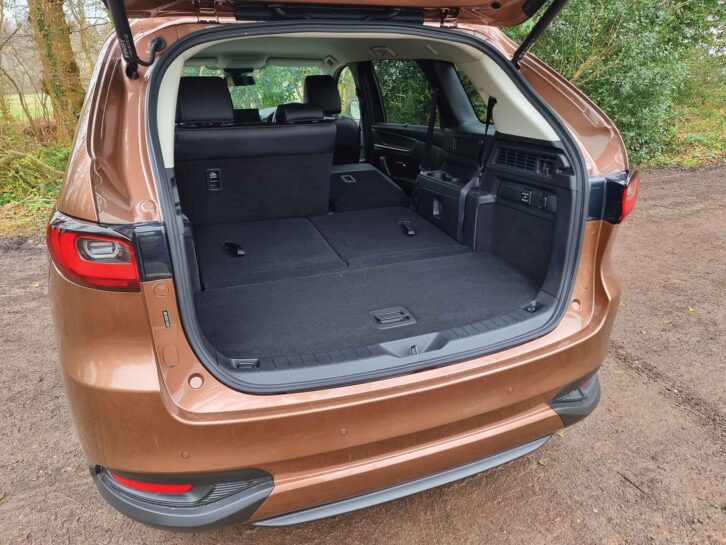
With all seats in place, there’s just about enough space for a weekly shop, with lots of luggage room if the third row is folded.
Buying and owning
With the diesel engine, the CX-80 starts from £52,205. That’s quite pricey when the Kia Sorento diesel costs from £41,995.
The Mazda goes some way to justifying this, with its stronger engine and long list of standard kit, even on the most affordable Exclusive Line car. This comes with 18-inch alloys, black leather seats, three-zone climate control, a head-up display, sat-nav, and wireless Android Auto and Apple CarPlay – there’s really no need to spend any more.
With mild-hybrid assistance, the diesel returns 49.6mpg on the combined cycle. I saw 27.6mpg while towing.
Alternatives to consider
See what I made of the Mazda CX-60 3.3 e-Skyactiv D MHEV 254ps AWD Homura when I put the diesel to the test – it’s a car that provides good performance and strong stability. Another SUV that proved stable and capable when I towed it was the Volvo XC60 Recharge Plug-in Hybrid T6 AWD Plus, a vehicle that also proved spacious.
Technical spec of the Mazda CX-80 3.3D AWD Exclusive Line
- Price: £52,205
- What Car? Target Price: £52,205
- Retained value after three years: N/A
- Kerbweight: 2061kg
- 85% of kerbweight: 1752kg
- Gross vehicle weight: 2781kg
- Max towing limit: 2500kg
- Gross train weight: 5281kg
- Towball limit: 100kg
- Price of towball: £1441.88
- Boot size: 258-1971 litres
- Payload: 720kg
- Test conditions: Dry
- Engine size: 3283cc
- Power (hp/rpm): 254/3750
- Torque (lb ft): 406/1500-2400
- Official combined economy: 49.6mpg
- Towing economy: 27.6mpg
- CO2 emissions: 148-151g/km
- First year car tax: £540
- Second year car tax: £620
- Insurance group: 37A
- Euro NCAP overall protection rating: 5/5
Before heading off, one thing you will want to make sure is your towing mirrors are correctly positioned – our guide to how to adjust towing mirrors will help here.
If you’ve enjoyed reading this article, why not get the latest news, reviews and features delivered direct to your door or inbox every month. Take advantage of our brilliant Practical Caravan magazine SUBSCRIBERS’ OFFER and SIGN UP TO OUR NEWSLETTER for regular weekly updates on all things caravan related.
Technical Specifications
| Engine Size | 3283 cc |
| Kerbweight | 2061 kg |
| 85% KW | 1752 kg |
| Towball Limit | 100 kg |
| Maximum Towing Limit | 2500 kg |
| Power | 254 bhp |
| Torque | 406 lb ft |
| Offical MPG | 49.6 mpg |
| Towing MPG | 27.6 mpg |
| CO₂ | 148-151 g/km |
